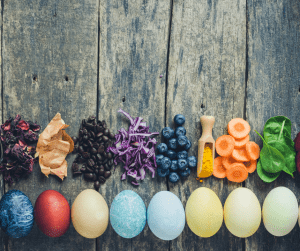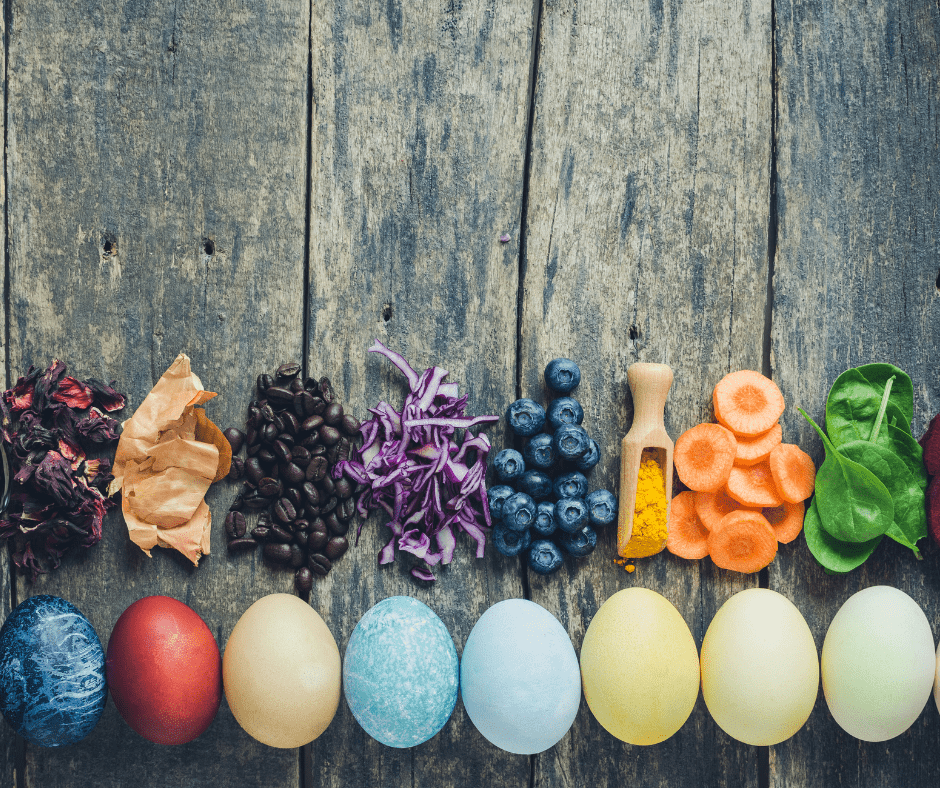Why do we even dye eggs? Historians seem to think that we started dying eggs back when the ancient Persians painted eggs for Nowruz, the Persian New Year. Around the 13th century it is believed eggs became what people would give to the churches as a special offering on Good Friday. For our family, dying eggs is simply a fun tradition to do in springtime. Spring brings flowers to bloom, warmer days, and family traditions.
How to Naturally Dye Easter Eggs
I can almost guarantee if you looked around your kitchen you would find ingredients to naturally dye your Easter eggs naturally. From red onion skins, red cabbage, red wine, black tea, red paprika, and yellow turmeric and even blueberries or loose tea. You can naturally dye eggs from your spices and vegetables.
It is important to remember that you aren’t going to get the same bright colors that artificial egg tablets and dyes would offer. However, you will be able to peel and know that you are eating eggs without those chemicals. You will probably notice swirls and freckles on the dry eggs and look like a beautiful watercolor painting. The unpredictability is their charm.
Preparing Your Eggs
You should have your fresh eggs at room temperature and cleaned with white vinegar. If you aren’t doing any special patterns or pressed flowers you can jump right in and start dying. If you would like to add herbs or flowers the materials you’ll need are: Clean stockings, leaves, herbs, and flowers. Whatever you would like. You will take the plant and push it gently up against the egg and put the egg inside the stocking and tightly twist and tie off the top. You will cook your eggs with the stocking still on.
Boiling Method
You will boil fresh eggs together with the coloring material and cook until the egg is hard boiled. For colors to be deeper or more intense, I would simply leave them in a bit longer. If you try out different ingredients, make sure to comment below with your own recipes. I love to learn new tips and tricks.
Recipe for light yellow to light orange tones:
3 tablespoons of turmeric
1 liter of water
3 tablespoons of vinegar
Pinch of salt
-Place fresh, room temperature eggs in lukewarm water with your ingredients and cook for about 25-35 minutes.
Recipe for purple tones:
1 liter of cheap red wine
Pinch of salt
-Place fresh eggs in cold wine and boil for 30 minutes or more.
Recipe for red tones:
Skins of red onions
1 liter of water
Pinch of salt
-Place fresh eggs in water with the skins of red onions and cook for 25-35 minutes. You can remove from heat and let them sit longer to have a strong pigment.
Fun “Egg Baby” Project For Kids:
You will need an egg, a needle or pin, paint or sharpie, material or construction paper.
Step 1: Hollow out your egg. Poke a hole at the top and at the bottom. Blow the yolk through one hole. Running warm water through the hole helps also.
Step 2: Decorate your egg baby. Let your imagination go with yarn, materials, and paint. Let your kiddos see how long they can keep it without getting cracked.
Happy Easter Egg Dying – Naturally
As you can see, it can be easy and fun to dye your Easter eggs naturally. I hope your family enjoys dying eggs naturally this Easter.
















